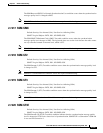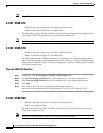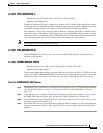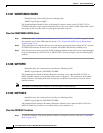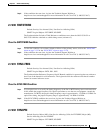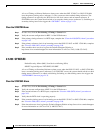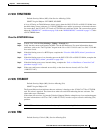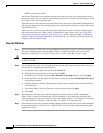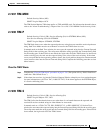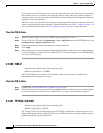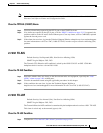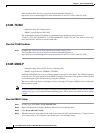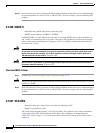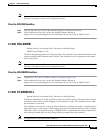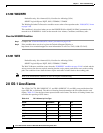
2-139
Cisco ONS 15310-CL and Cisco ONS 15310-MA Troubleshooting Guide, R7.0
Chapter 2 Alarm Troubleshooting
2.7.237 TIM-MON
2.7.237 TIM-MON
Default Severity: Minor (MN)
SONET Logical Object: OCN
The TIM Section Monitor TIM alarm applies to TXP and MXP cards. For information about this alarm,
refer to the “Alarm Troubleshooting” chapter of the Cisco ONS 15454 DWDM Troubleshooting Guide.
2.7.238 TIM-P
Default Severity: Critical (CR), Service-Affecting (SA) for STSTRM; Minor (MN),
Non-Service-Affecting (NSA) for STSMON
SONET Logical Objects: STSMON, STSTRM
The TIM Path alarm occurs when the expected path trace string does not match the received path trace
string. Path Trace Mode must be set to Manual or Auto for the TIM-P alarm to occur.
In manual mode at the Path Trace window, the user types the expected string into the Current Expected
String field for the receiving port. The string must match the string typed into the Transmit String field
for the sending port. If these fields do not match, the login node raises the TIM-P alarm. In Auto mode
on the receiving port, the card sets the expected string to the value of the received string. If the alarm
occurs on a port that has been operating with no alarms, the circuit path has changed or someone entered
a new incorrect value into the Current Transmit String field. Complete the following procedure to clear
either instance.
Clear the TIM-P Alarm
Step 1 Complete the “Clear the TIM Alarm” procedure on page 2-138. (The option will say “Edit J1 Path Trace”
rather than “Edit J0 Path Trace.”)
Step 2 If the alarm does not clear, log into the Technical Support Website at http://www.cisco.com/techsupport
for more information or call Cisco TAC (1-800-553-2447). If the alarm applies to the STSTRM object,
it is Service-Affecting (SA).
2.7.239 TIM-S
Default Severity: Critical (CR), Service-Affecting (SA)
SONET Logical Objects: EC1, OCN
The TIM for Section Overhead alarm occurs when there is a mismatch between the expected and
received J0 section overhead strings in either Manual or Auto mode.
In manual mode at a 15310-CL-CTX, DS1-28/DS3-EC1-3, or DS1-84/DS3-EC1-3 Section Trace
window, the user enters the expected string into the Current Expected String field for the receiving port.
The string must match the string typed into the Transmit String field for the sending port. If these fields
do not match, the login node raises the TIM-S alarm.



